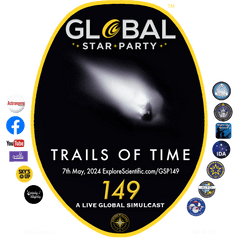
Exploring the Universe with David Eicher: A Look at Keenan's System during the 148th Global Star Party
David Eicher, the Editor in Chief of Astronomy Magazine, is well-known for his dynamic role in bringing the cosmos closer to astronomy enthusiasts. One of his notable regular engagements is participating in the Explore Alliance's Global Star Party. During these events, Eicher takes on the role of a celestial guide, leading participants through the universe to explore often overlooked celestial gems. His passion for astronomy not only enlightens but also inspires participants to look beyond the familiar and delve deeper into the cosmos.
In the 148th edition of the Global Star Party, David Eicher focused on a particularly intriguing celestial duo known as Keenan's System (Arp 104), consisting of the galaxies NGC 5216 and NGC 5218. Discovered by the legendary astronomer William Herschel in 1790, these galaxies reside in the constellation Ursa Major, situated about 17 million light-years from Earth. Despite their early discovery, Arp 104 did not garner much attention until the mid-20th century.
The pair consists of an elliptical galaxy (NGC 5216) and a barred spiral galaxy (NGC 5218), initially seeming just like any distant galactic neighbors. However, in 1945, Philip Keenan spotted a faint but definite band of nebulosity connecting the two, a pivotal observation that was only widely acknowledged after further observations by the Lick and Palomar observatories in 1958. This discovery highlighted a fascinating aspect of galaxy interaction and dynamics.
During his presentation, Eicher elaborated on the cosmic drama unfolding between these two galaxies. The faint filament connecting them is believed to be the result of a near-miss encounter about 200 million years ago. This close interaction did not only warp the spiral arms of NGC 5218 and create a comma-shaped extension in NGC 5216 but also ignited the formation of new, hot, massive stars within the connecting filament. These stars, shining brightly in blue hues, suggest ongoing star formation activity within the filament, which extends into a plume almost 46,000 light-years long.

David Eicher's presentations at the Global Star Party serve as a powerful reminder of the dynamic universe we inhabit. It's not just about the stars and planets that we can easily see; it's also about the subtle yet profound interactions that occur over millions of years, shaping the structure and fate of galaxies. We are honored that through the GSP, Eicher encourages a deeper appreciation for the often hidden wonders of the universe.
The 149th Global Star Party with the theme of "Trails of Time" will get underway on May 7th, 2024 starting at 6:00 p.m. Central. This theme plays into the backdrop provided by the Eta Aquarids meteor shower that will peak on May 6th, that is known for its ties to Halley's Comet. Where we will discuss topics that will touch on the historical and cosmic links between periodic comets like Halley's and their influence on meteor showers, emphasizing the interconnectedness and ongoing evolution of our universe. To learn more about the speakers and the schedule visit explorescientific.com/gsp149.


Leave a comment